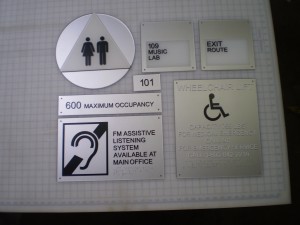Like most anything there are a variety of ways to make ADA signs. Consequently we decided it may be beneficial to discuss three of the most popular processes used in fabricating these sign types as follows:
Photopolymer ADA signs: The tactile lettering and Braille are an integral part of the sign. The process involves the use of chemicals and light to “wash” away the excess resin material leaving the raised letters and Braille in place and sitting above the lower surface. The result is an integrated one-piece sign which is then painted.
Applied ADA signs: These signs are made by attaching the letters and Braille to an acrylic backer plate. The outline of the letter and Braille beads are etched onto the backer and a thin bead of glue is placed to hold the solid plastic letters and Braille beads in place.
Embedded (Inlaid) ADA signs: In this method the shape of letters and Braille beads are routed out from the acrylic backer and a recessed area is formed. A bonding agent is dropped into the recessed area to materially embed and chemically weld the letters and Braille beads with the backer plate. This approach is most prevalent in schools and prisons because the letters and Braille are not easily pried off from the undersurface. This method protects against sign vandalism.
We have used, at different times and for different projects, each of the above ADA sign types. If you are contemplating an ADA sign project we can help you to decide which approach is best for you given the environment and your budget. Contact SignWorks at (510) 357-2000 or email us at info@signworks.us.com

